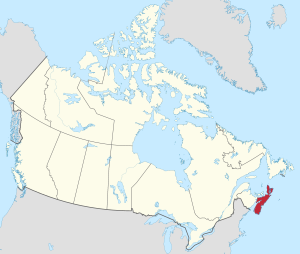
Back Nova Scotia Afrikaans ኖቫ ስኮሻ Amharic Niwe Scotland ANG نوفا سكوشا Arabic ܢܘܒܐ ܣܩܘܛܝܐ ARC نوڤا سكوشا ARZ Nueva Escocia AST नोवा स्कॉटिया AWA Yeni Şotlandiya Azerbaijani نووا اسکوشیا AZB
Nova Scotia
| |
|---|---|
| Motto(s): | |
| Coordinates: 45°N 63°W / 45°N 63°W[3] | |
| Country | Canada |
| Confederation | 1 July 1867 (1st, with New Brunswick, Ontario, Quebec) |
| Capital (and largest city) | Halifax |
| Largest metro | Halifax |
| Government | |
| • Type | Parliamentary constitutional monarchy |
| • Lieutenant Governor | Mike Savage |
| • Premier | Tim Houston |
| Legislature | Nova Scotia House of Assembly |
| Federal representation | Parliament of Canada |
| House seats | 11 of 338 (3.3%) |
| Senate seats | 10 of 105 (9.5%) |
| Area | |
• Total | 55,284 km2 (21,345 sq mi) |
| • Land | 52,942 km2 (20,441 sq mi) |
| • Water | 2,342 km2 (904 sq mi) 4.2% |
| • Rank | 12th |
| 0.6% of Canada | |
| Population (2021) | |
• Total | 969,383[4] |
• Estimate (Q4 2024) | 1,079,676[5] |
| • Rank | 7th |
| • Density | 18.31/km2 (47.4/sq mi) |
| Demonym(s) | Nova Scotian, Bluenoser |
| Official languages | Canadian English (de jure)[6] First Language: Mi'kmawi'simk[7][8] Recognized Regional Languages: Canadian French, Canadian Gaelic |
| GDP | |
| • Rank | 7th |
| • Total (2020) | CA$46.849 billion[9] |
| • Per capita | CA$52,390 (12th) |
| HDI | |
| • HDI (2019) | 0.903[10] — Very high (11th) |
| Time zone | UTC-04:00 (Atlantic) |
| • Summer (DST) | UTC-03:00 (ADT) |
| Canadian postal abbr. | NS |
| Postal code prefix | |
| ISO 3166 code | CA-NS |
| Flower | Mayflower |
| Tree | Red spruce |
| Bird | Osprey |
| Rankings include all provinces and territories | |
Nova Scotia[a] is a province of Canada, located on its east coast. It is one of the three Maritime provinces and most populous province in Atlantic Canada, with an estimated population of over 1 million as of 2024; it is also the second-most densely populated province in Canada, and second-smallest province by area.[11] The province comprises the Nova Scotia peninsula and Cape Breton Island, as well as 3,800 other coastal islands. The province is connected to the rest of Canada by the Isthmus of Chignecto, on which the province's land border with New Brunswick is located.
Nova Scotia's capital and largest municipality is Halifax, which is home to over 45% of the province's population as of the 2021 census. Halifax is the twelfth-largest census metropolitan area in Canada,[12] the largest municipality in Atlantic Canada, and Canada's second-largest coastal municipality after Vancouver.
The land that makes up what is now Nova Scotia was inhabited by the Miꞌkmaq people at the time of European colonization. In 1605, Acadia—France's first New France colony—was founded with the creation of Acadia's capital, Port Royal.[13] The Scots, English, then British, fought France for the territory on numerous occasions for over a century afterwards, having gained it from them in the 1713 Peace of Utrecht, which ended the War of the Spanish Succession. In subsequent years, the British began settling "foreign Protestants" in the region and deported the French-speaking Acadians en masse. During the American Revolutionary War (1775–1783), thousands of Loyalists settled in Nova Scotia.
In 1848, Nova Scotia became the first British colony to achieve responsible government. In July 1867, Nova Scotia joined in Confederation with New Brunswick and the Province of Canada (now Ontario and Quebec), forming the Dominion of Canada.
- ^ Government of Canada, Natural Resources Canada. "Place names – Nouvelle-Écosse / Nova Scotia". www4.rncan.gc.ca. Archived from the original on 10 June 2020. Retrieved 16 April 2020.
- ^ Province of Nova Scotia, Gaelic Affairs. "Nova Scotia/Alba Nuadh". gaelic.novascotia.ca. Archived from the original on 23 April 2020. Retrieved 21 April 2020.
- ^ "Nova Scotia". Geographical Names Data Base. Natural Resources Canada.
- ^ "Population and dwelling counts: Canada, provinces and territories". Statistics Canada. 9 February 2022. Archived from the original on 9 February 2022. Retrieved 9 February 2022.
- ^ "Population estimates, quarterly". Statistics Canada. 27 September 2023. Archived from the original on 28 September 2023. Retrieved 28 September 2023.
- ^ "The Legal Context of Canada's Official Languages". University of Ottawa. Archived from the original on 10 October 2017. Retrieved 7 March 2019.
- ^ "Legislation Enshrines Mi'kmaw as Nova Scotia's First Language". Province of Nova Scotia (in English and Mi'kmaw). L'nu Affairs. 7 April 2022. Archived from the original on 2 May 2022. Retrieved 19 June 2022.
- ^ Mi'kmaw Language Act, SNS 2022, c. 5.
- ^ "Gross domestic product, expenditure-based, provincial and territorial, annual (x 1,000,000)". Statistics Canada. 9 November 2021. Archived from the original on 23 April 2022. Retrieved 8 May 2022.
- ^ "Sub-national HDI – Global Data Lab". globaldatalab.org. Archived from the original on 18 July 2021. Retrieved 18 July 2021.
- ^ "Census Profile, 2016 Census - Nova Scotia [Province] and Canada [Country]". Statistics Canada. 8 February 2017. Archived from the original on 25 February 2021. Retrieved 8 February 2017.
- ^ Beck, J. Murray (7 April 2009). "Nova Scotia". The Canadian Encyclopedia. Archived from the original on 6 November 2021. Retrieved 4 March 2020.
- ^ Cite error: The named reference
Morton1999was invoked but never defined (see the help page).
Cite error: There are <ref group=lower-alpha> tags or {{efn}} templates on this page, but the references will not show without a {{reflist|group=lower-alpha}} template or {{notelist}} template (see the help page).


